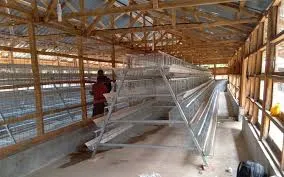poultry layer cage
Oct . 11, 2024 01:28 Back to list
poultry layer cage
The Role of Poultry Layer Cages in Modern Egg Production
The poultry industry plays a pivotal role in the global agricultural landscape, particularly in egg production. As the demand for eggs continues to rise due to their nutritional value and versatility, the methods of raising laying hens have evolved significantly. Among these methods, poultry layer cages have emerged as a popular solution, offering various benefits that appeal to both producers and consumers.
Understanding Poultry Layer Cages
Poultry layer cages are specially designed enclosures used to house hens that are raised for egg production. These cages are typically constructed from metal and are arranged in multi-tiered systems, which maximizes space and allows farmers to raise a larger number of hens in a controlled environment. The cages are designed to keep hens separate from one another, reducing the risk of pecking and increasing individual health and productivity.
Advantages of Layer Cages
One of the primary advantages of using layer cages is the enhanced biosecurity they provide. By limiting the space in which hens can move, layer cages help prevent the spread of diseases among birds. This is particularly important in large-scale operations where a single infection could lead to catastrophic losses. Additionally, this confinement simplifies management practices. Farmers can easily monitor the health and behavior of each hen, providing timely interventions when necessary.
Another significant benefit is the improved feed conversion ratio. Hens in layer cages tend to exhibit better feed efficiency compared to those raised in free-range or floor systems. The controlled environment reduces stress and competition for food, leading to healthier birds that lay more eggs. Moreover, since the hens are housed in clean environments, the quality of both the eggs and the manure produced is generally higher, offering advantages for both animal welfare and farm sustainability.
poultry layer cage

Animal Welfare Concerns
Despite their benefits, layer cages have faced criticism regarding animal welfare. Animal rights groups argue that confining hens to cages can result in physical and psychological distress, as the hens have limited space to move. In response to these concerns, many producers have begun to adopt enriched cages, which provide additional amenities such as nesting areas, perches, and more space for movement. This approach aims to strike a balance between production efficiency and the well-being of the hens.
Additionally, the trend towards cage-free systems is gaining traction among consumers who prioritize ethical treatment of animals. In some regions, legislation has been passed to phase out conventional cages altogether, prompting farmers to invest in alternative housing systems. Consequently, the poultry industry is at a crossroads, navigating the complexities of consumer preferences, regulatory changes, and operational efficiencies.
The Future of Layer Cages
The future of poultry layer cages appears to be a blend of traditional practices and modern innovations. As technology continues to advance, farmers are exploring new methods to enhance the welfare of hens while maintaining efficient production. For example, the introduction of smart farming technologies, such as automated feeding systems and environmental monitoring, allows producers to create optimal living conditions for their hens within cage systems.
Furthermore, research into the nutritional requirements of laying hens and the impacts of different housing systems is ongoing. By understanding these dynamics better, the industry can design more effective and humane methods of egg production.
In conclusion, poultry layer cages play a crucial role in modern egg production, providing a reliable and efficient method for raising hens. While challenges related to animal welfare remain, the industry is evolving to find sustainable solutions that meet the demands of consumers and producers alike. As we move forward, it will be essential to maintain a dialogue between all stakeholders, ensuring that the benefits of layer cages are balanced with the ethical considerations surrounding the treatment of poultry.
-
Hot Sale 24 & 18 Door Rabbit Cages - Premium Breeding Solutions
NewsJul.25,2025
-
Automatic Feeding Line System Pan Feeder Nipple Drinker - Anping County Yize Metal Products Co., Ltd.
NewsJul.21,2025
-
Automatic Feeding Line System Pan Feeder Nipple Drinker - Anping County Yize Metal Products Co., Ltd.
NewsJul.21,2025
-
Automatic Feeding Line System - Anping Yize | Precision & Nipple
NewsJul.21,2025
-
Automatic Feeding Line System - Anping Yize | Precision & Nipple
NewsJul.21,2025
-
Automatic Feeding Line System-Anping County Yize Metal Products Co., Ltd.|Efficient Feed Distribution&Customized Animal Farming Solutions
NewsJul.21,2025






